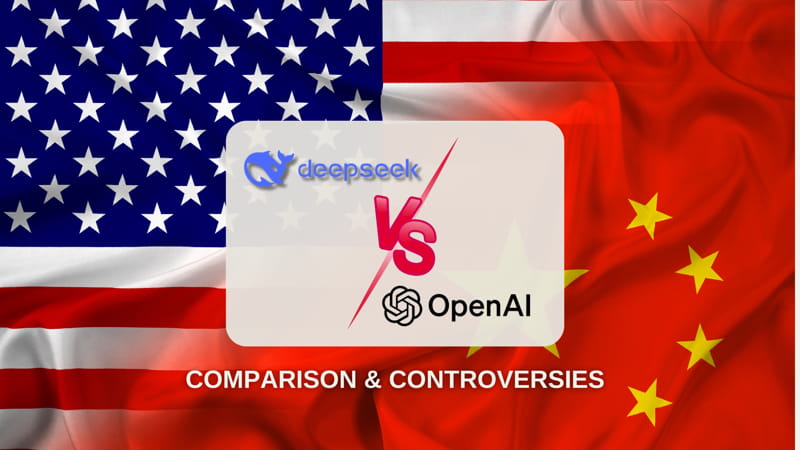As artificial intelligence evolves, developers, businesses, and individuals have a wide range of AI models to choose from. DeepSeek-R1 stands as a robust new contender alongside established models like OpenAI’s GPT (including GPT-4) and other available AI platforms. Below, we’ll compare DeepSeek-R1 with OpenAI GPT-4 (the latest release in the GPT series), and some other key players in the market, focusing on aspects such as performance, accessibility, cost, and features.
Objective Comparison
1. Model Size and Parameters
DeepSeek-R1 boasts 671 billion parameters, but only 37 billion active parameters are in use during operation. This is highly efficient compared to other models, balancing performance and resource consumption.
- DeepSeek-R1:
- Total Parameters: 671 billion
- Active Parameters in Operation: 37 billion
- Efficiency: High (optimized use of parameters)
- OpenAI GPT-4:
- Total Parameters: 500 billion to 1 trillion (estimated)
- Active Parameters in Operation: Varies
- Efficiency: Moderate to high (more focused on general purpose and handling large datasets)
- Anthropic Claude (Alternative AI Platform):
- Total Parameters: Not publicly disclosed
- Efficiency: Optimized for safety and conversational AI, with a focus on reducing biases
- Google PaLM 2:
- Total Parameters: 540 billion
- Efficiency: Focused on language understanding, translation, and generative tasks
Analysis:
While DeepSeek-R1 has a significantly higher number of parameters (671 billion), it stands out due to its efficient utilization of only 37 billion active parameters, making it a lighter, resource-efficient model compared to some of the massive, heavy models like OpenAI’s GPT-4, which requires extensive hardware for effective operation.
2. Open-Source vs Closed-Source
DeepSeek-R1 is open-source and released under the MIT License, allowing developers to modify, use, and distribute the model freely, even for commercial purposes.
- DeepSeek-R1:
- Open-Source: Yes (MIT License)
- Commercial Use: Allowed (free modification and redistribution)
- OpenAI GPT-4:
- Open-Source: No
- Commercial Use: Yes (via API subscription plans)
- Customization: Limited (Access and customization are confined to OpenAI’s ecosystem)
- Anthropic Claude:
- Open-Source: No
- Commercial Use: Yes (through API access)
- Customization: Limited, focused on specific use cases like conversation safety
- Google PaLM 2:
- Open-Source: No
- Commercial Use: Yes (via API access)
- Customization: Limited
Analysis:
DeepSeek-R1 is the only model in this comparison that offers complete open-source access, providing immense flexibility for developers to tailor the AI to specific needs. In contrast, OpenAI GPT-4, Anthropic Claude, and Google PaLM 2 are all closed-source, limiting customization and usage to their respective platforms.
3. Cost of Usage
The cost of using an AI model plays a crucial role in its adoption, especially for developers and small businesses. Let’s compare the API pricing of DeepSeek-R1 with that of OpenAI GPT-4 and others.
- DeepSeek-R1:
- API Pricing:
- $0.14 per million incoming tokens
- $2.19 per million output tokens
- Affordability: Very cost-effective, with highly competitive rates for developers.
- API Pricing:
- OpenAI GPT-4:
- API Pricing:
- $0.03 per 1,000 tokens (approx. for GPT-4 with text completion)
- $0.12 per 1,000 tokens for DaVinci model (GPT-3.5)
- Affordability: Generally more expensive for larger datasets and outputs, especially for the more powerful models (like GPT-4).
- API Pricing:
- Anthropic Claude:
- API Pricing:
- Pricing information is not widely disclosed but is comparable to GPT-4.
- API Pricing:
- Google PaLM 2:
- API Pricing:
- Pricing details for PaLM 2 are often flexible based on usage, with pay-per-use rates similar to other models but can be higher for extensive queries.
- API Pricing:
Analysis:
In terms of API pricing, DeepSeek-R1 offers the most affordable rates, especially for both incoming and output tokens. This makes it a great choice for developers and businesses that need a cost-effective solution. OpenAI GPT-4 and other models, although offering powerful capabilities, are typically more expensive, especially when handling high-volume tasks.
4. Performance and Benchmarking
AI model performance can be measured in different ways: how well it solves problems, generates answers, and its efficiency in specific tasks.
- DeepSeek-R1:
- Performance: Exceptional in logical reasoning, in-depth analysis, and answer validity.
- Benchmarking: Proven superior performance in tests like AIME, MATH-500, and SWE-bench Verified.
- OpenAI GPT-4:
- Performance: Excellent in general-purpose tasks like conversation, content generation, and translation.
- Benchmarking: Strong in language understanding, with great results in tests like SuperGLUE and MATH.
- Anthropic Claude:
- Performance: Specializes in safety and conversational intelligence with a focus on ethical responses.
- Benchmarking: Strong performance in filtering out toxic responses and ensuring user safety.
- Google PaLM 2:
- Performance: Known for strong language and problem-solving capabilities, particularly in natural language understanding.
- Benchmarking: Strong at understanding complex sentences and providing accurate translations and answers.
Analysis:
In terms of problem-solving and logical thinking, DeepSeek-R1 excels, particularly in tasks that require deep analysis and reasoning. Its superior performance in specialized benchmarks such as AIME and MATH-500 makes it particularly suitable for industries where accuracy and logical problem-solving are critical. GPT-4, on the other hand, is a more general-purpose model, excelling at conversation and content generation.
5. Applications and Use Cases
Each AI platform has strengths depending on its focus and design. Here’s how the platforms compare in various applications:
- DeepSeek-R1:
- Ideal for industries requiring complex problem-solving, logical reasoning, and programming assistance.
- Strong in sports analytics and complex data analysis.
- OpenAI GPT-4:
- Best suited for content generation, conversation, and translation.
- Versatile across business and creative industries.
- Anthropic Claude:
- Specialized in conversational AI, focusing on safety, user interaction, and reducing biases.
- Google PaLM 2:
- Strong in natural language understanding and tasks like translation, summarization, and content generation.
Analysis:
If your focus is on programming assistance, data analysis, or logical problem-solving, DeepSeek-R1 outshines the others. For broader content generation and conversational tasks, OpenAI GPT-4 and Google PaLM 2 provide excellent solutions. Anthropic Claude focuses more on ethical conversations and is better for those needing safe, bias-free interactions.
6. Accessibility and Support
- DeepSeek-R1:
- Open-source and easily accessible through both a website and API.
- Community-driven support and documentation.
- OpenAI GPT-4:
- Requires access via API subscriptions, with extensive official documentation.
- Premium support for enterprise users.
- Anthropic Claude:
- Available through API access, with a focus on safe deployment and ethical guidelines.
- Google PaLM 2:
- API-based access, integrated into Google Cloud services.
Analysis:
DeepSeek-R1 offers the most accessible model in terms of open-source availability, whereas OpenAI GPT-4, Anthropic Claude, and Google PaLM 2 require paid access, limiting immediate use for those without a subscription or enterprise license.
Controversies & Fuss Around DeepSeek (China) & Open AI (USA)
The emergence of DeepSeek-R1, developed by China’s AI startup DeepSeek, has ignited significant discussions and controversies in the global media, particularly in comparison to OpenAI’s ChatGPT. The debates center around several key areas:
1. Data Privacy and National Security Concerns | Transparency & Accountability
DeepSeek-R1 has faced scrutiny over its data handling practices. Reports indicate that the application collects and stores user data on servers located in China, raising alarms about potential national security risks. This concern mirrors previous apprehensions associated with other Chinese applications, such as TikTok. Notably, members of the U.S. military have been cautioned against using DeepSeek due to these security implications.
- Black Box Nature: The inner workings of these AI models are complex and not fully transparent, leading to questions about how decisions are made and who is accountable for those decisions.
- Data Privacy: There are worries about how user data is handled, especially in the context of interactions with these models. Users and regulators are concerned about potential misuse of personal data.
2. Censorship and Content Moderation | Ethical Concerns
Analyses have revealed that DeepSeek-R1 employs censorship mechanisms, particularly on topics deemed politically sensitive by the Chinese government. For instance, the model avoids discussions related to events like the 1989 Tiananmen Square protests, the persecution of Uyghurs, or broader human rights issues in China. When such topics are broached, the AI often deflects, stating: “Sorry, that’s beyond my current scope. Let’s talk about something else.” This behavior has led to concerns about the influence of state censorship on AI outputs.
- Bias and Fairness: Both DeepSeek-R1 and ChatGPT have faced scrutiny over potential biases in their outputs. Critics argue that these models can inadvertently perpetuate stereotypes or exhibit biased behavior based on the data they were trained on.
- Misinformation: There are concerns that these models could be used to generate and spread misinformation, either intentionally or unintentionally, due to their ability to produce highly convincing text.
3. Intellectual Property and Training Data | Economic & Social Impact
OpenAI is reportedly investigating whether DeepSeek utilized large volumes of data from OpenAI’s tools to develop its technology, possibly through a process known as distillation. This raises questions about the originality of DeepSeek’s model and the ethical implications of using another company’s data without explicit permission.
- Job Displacement: There is a fear that AI models like DeepSeek-R1 and ChatGPT could automate tasks traditionally performed by humans, leading to job displacement in various sectors.
- Concentration of Power: The development and control of such advanced AI technologies are concentrated in the hands of a few companies, raising concerns about monopolistic practices and the potential for misuse of power.
4. Geopolitical Implications in the AI Race | Regulation & Governance
The rapid advancement of DeepSeek-R1 has intensified the global AI race, challenging the dominance of U.S.-based companies like OpenAI. DeepSeek’s open-source approach and significant achievements have prompted discussions about the shifting balance in AI innovation and the broader geopolitical consequences.
- Lack of Clear Regulations: The rapid advancement of AI technology has outpaced the development of regulatory frameworks, leading to a lack of clear guidelines on how these models should be used and governed.
- Global Standards: Different countries have different approaches to AI regulation, leading to a fragmented landscape and potential conflicts in how these technologies are managed globally.
Objective Perspective
DeepSeek-R1’s introduction marks a pivotal moment in AI development, showcasing impressive technical capabilities and an open-source model that fosters innovation. However, the associated controversies underscore the necessity for comprehensive discussions on data privacy, ethical AI practices, and the geopolitical ramifications of technological advancements. As the AI landscape evolves, it is crucial for stakeholders to collaboratively establish frameworks that ensure responsible development and deployment, balancing innovation with ethical considerations and security concerns.
From an objective standpoint, it’s important to recognize both the potential benefits and risks associated with AI models like DeepSeek-R1 and ChatGPT:
- Benefits: These models have the potential to revolutionize various industries by improving efficiency, enabling new forms of creativity, and providing valuable insights through data analysis. They can also democratize access to information and assist in educational contexts.
- Risks: The ethical concerns, potential for misuse, and societal impacts cannot be ignored. It is crucial for developers, regulators, and stakeholders to work together to address these issues proactively. This includes implementing robust ethical guidelines, ensuring transparency, and developing regulatory frameworks that balance innovation with accountability.
Conclusion
While DeepSeek-R1 shines with its affordable pricing, open-source flexibility, and superior performance in problem-solving and complex reasoning tasks, other models like OpenAI GPT-4 excel in general-purpose tasks such as content generation and conversation. The best model depends on your specific needs—whether you prioritize cost, openness, or specialized capabilities.
In conclusion, while the advancements in AI technology are impressive and hold great promise, they also come with significant responsibilities. The ongoing dialogue in the media reflects the need for a balanced approach that maximizes the benefits while mitigating the risks.








3 Responses